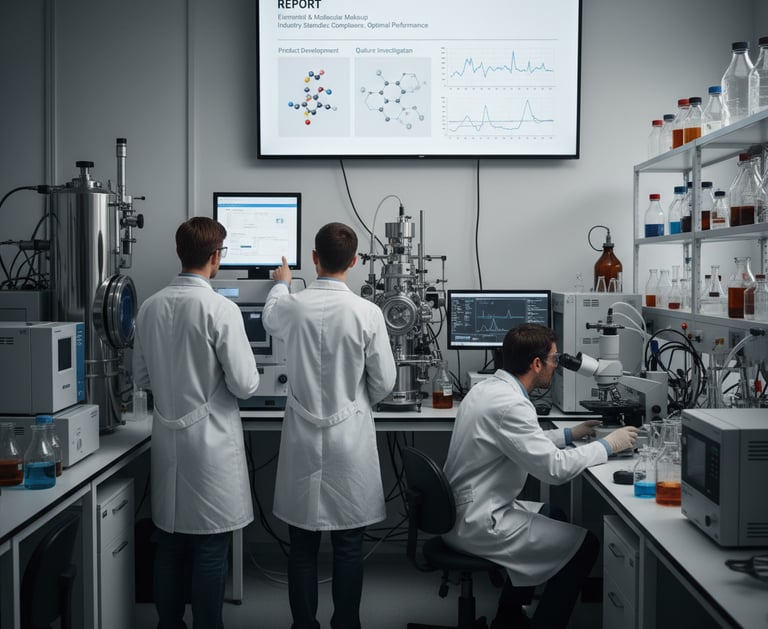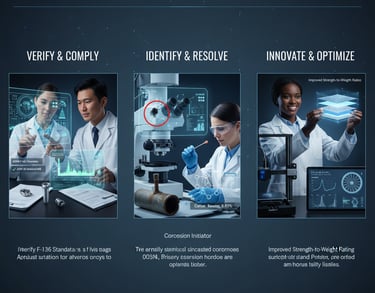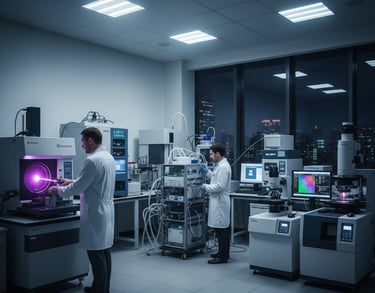
Chemical Analysis
Unveiling Material Composition for Performance and Safety
Precision Chemical Analysis for Material Excellence
our advanced chemical analysis services provide a crucial understanding of material composition, enabling informed decisions for product development, quality control, and failure investigation. We delve into the elemental and molecular makeup of your materials, ensuring they meet the most stringent industry standards and perform optimally in their intended applications.


Why Chemical Analysis Matters
Understanding the precise chemical composition of a material is paramount across diverse industries. It impacts everything from mechanical properties and corrosion resistance to biocompatibility and regulatory compliance. Our chemical analysis helps you:
Verify Material Specifications: Confirm that raw materials and finished products meet design requirements and industry standards.
Identify Contaminants & Impurities: Detect undesirable elements that can compromise material performance or lead to premature failure.
Support Failure Analysis: Determine the root cause of material degradation or failure by analyzing compositional changes.
Aid Reverse Engineering: Understand the composition of competitor products or legacy components.
Ensure Regulatory Compliance: Meet strict industry regulations in sectors like aerospace, medical devices, and automotive.


The Foundation of Material Integrity
Our Comprehensive Chemical Analysis Capabilities
We employ a wide array of state-of-the-art analytical techniques, each selected for its precision, sensitivity, and applicability to various material types and analytical challenges. Our experienced chemists and metallurgists utilize these methods to deliver comprehensive and reliable data.
Optical Emission Spectrometry (OES):
Text: Ideal for rapid, quantitative elemental analysis of metals and alloys (e.g., steels, aluminum, copper). Provides precise measurements of major, minor, and trace elements.
Inductively Coupled Plasma – Optical Emission Spectrometry (ICP-OES):
Text: A highly sensitive method for multi-elemental analysis in solutions. Used for trace element detection in a wide range of materials after suitable sample preparation.
X-Ray Fluorescence (XRF):
Text: Non-destructive elemental analysis for solids, liquids, and powders. Excellent for qualitative and quantitative analysis of a broad spectrum of elements, often used for material identification and coating thickness.
Energy Dispersive X-ray Spectroscopy (EDS/EDX) (often paired with SEM):
Text: Provides elemental composition at a micro-scale, often integrated with Scanning Electron Microscopy (SEM) for spatially resolved analysis of surfaces, particles, and inclusions.
Combustion Analysis (C, S, O, N, H):
Text: Precisely determines the content of carbon, sulfur, oxygen, nitrogen, and hydrogen in various materials, critical for understanding mechanical properties and material grades.
Fourier-Transform Infrared Spectroscopy (FTIR):
Text: Identifies organic compounds and functional groups in polymers, plastics, lubricants, and coatings. Useful for material identification, contaminant detection, and degradation studies.
Gas Chromatography-Mass Spectrometry (GC-MS):
Text: Separates and identifies volatile and semi-volatile organic compounds. Essential for analyzing gases, liquids, and extracts from solid materials, often used in failure analysis and contaminant identification.
Atomic Absorption Spectroscopy (AAS):
Text: Highly sensitive for the quantitative determination of individual metallic elements in solution.


